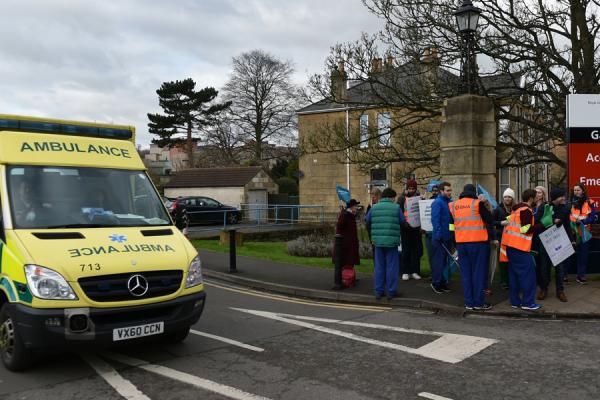30% of life or death emergency ambulance calls are not responded to in 8 minutes

GMB analysis of ambulance response times show 30% of life or death emergency calls are not responded to within 8 minutes.
Proper investment and full recognition of skills is needed to solve the problems around the recruitment and retention of ambulance staff says GMB. GMB, the union for ambulance staff, has analysed new data that shows ambulance services across England are consistently failing to achieve vital targets set for response times.
According to data for January Red 1 emergency calls, those involving life threatening respiratory or heart issues, were responded to within 8 minutes only 69.9% of the time. This amounts to almost 5,000 emergency calls that were not reached within 8 minutes. For Red 2 calls, all other life threatening emergencies, only 63.3% of calls were responded to within 8 minutes amounting to 107,582 emergency calls that missed the vital 8 minute window. The target for these categories of emergencies is to reach patients within 8 minutes at least 75% of the time.
January is the 8th consecutive month in which the UK ambulance service has not met targets set for red 1 emergencies.
PERFORMANCE TARGETS FOR AMBULANCE TRUSTS IN ENGLAND FOR JAN 2016 COMPARED TO JAN 2016 – Figures available from contacts below
Rehana Azam, GMB National Officer for NHS staffs, said “The situation is at critical when 30% of life or death emergency calls are not responded to within 8 minutes. The government has created conditions which mean the public now have to wait longer for the ambulance service to respond. High vacancy rates and staff shortages mean existing staff have to shoulder more responsibility and crews responding to 999 calls are not adequately staffed. The service needs if we are to retain staff.
The current leaving rate in England of 6.1% for qualified ambulance staff is outstripping the joining rate of 4.3%. The situation is getting worse. With vacancy levels at over 1,200 in the ambulance service, the Government must act fast if they want to seriously try and hit the response time targets. Jeremy Hunt is acting irresponsibly, proper investment and full recognition of skills is needed to solve the problems around the recruitment and retention of ambulance staff.”
End Contact: Rehana Azam on 07841 181656 or GMB press office on 07970 863411 or 07739 182691
Notes to editors
1 Definitions
Red Calls (Red 1 and 2)
These are calls that are classified as immediately life threatening and require an emergency response (with blue lights). The target is to arrive at these patients within eight minutes in 75% of cases. Examples are: Red 1: Cardiac arrest or life-threatening traumatic injuries; Red 2: Serious breathing difficulties or suspected stroke with serious symptoms.
From June 2012 Category A calls were split into Red 1 (most serious/time critical) and Red 2 (serious but less time critical). 2 Data was released Thursday 10 March 2016 by NHS England: https://www.england.nhs.uk/statistics/statistical-work-areas/combined-performance-summary/ 3 Copy of GMB press release dated Thursday, July 31, 2014 New Data On Ambulance Response Times For Emergency Calls Shows Service Under Pressure
Our Ambulance Service needs seriously targeted funds so that the public can be adequately protected says GMB.
GMB, the union for ambulance staff, has analysed the data released today (31 July) which shows that East Midlands and East of England are not hitting the targets of Red 1 or Red 2 cat A calls within 8 minutes. South West is also missing target for Red 1. West Midlands and South East Coast are missing target for Red 2.
Red 1 and Red 2 are calls that are classified as immediately life threatening and require an emergency response (with blue lights). The target is to arrive at these patients within eight minutes in 75% of cases. See notes to editors for definitions and sources.
Comparing the data for the period from June 2012 to March 2013 and for April 2013to March 2014l for Red 2 the position has deteriorated in eight of the twelve Trusts.
PERFORMANCE TARGETS FOR AMBULANCE TRUSTS IN ENGLAND FOR 2013/14 COMPARED TO 2012/13 2012-13 (June – March) 2013-14 Red 1 Red 2 Red 1 Red 2 change England 74.0 75.6 75.6 74.8 1.6 -0.8 North East 76.6 76.5 76.9 78.4 0.4 1.9 North West 73.5 76.6 75.9 77.4 2.4 0.8 Yorkshire 71.7 75.2 77.4 75.1 5.7 -0.1 East Midlands 70.0 75.5 71.3 71.4 1.2 -4.1 West Midlands 78.9 75.5 80.0 73.6 1.0 -2.0 East of England 74.2 72.8 73.6 69.4 -0.6 -3.4 London 77.7 76.3 77.4 75.3 -0.4 -1.0 South East Coast 75.1 75.1 76.8 73.9 1.7 -1.2 South Central 78.2 75.2 79.2 75.7 1.0 0.5 South Western 74.3 76.2 73.1 77.2 -1.1 1.0 Isle of Wight 78.7 76.6 80.2 76.1 1.5 -0.5
Rehana Azam, GMB National Officer for NHS staffs, said “The government has created the conditions which means the public are now having to wait longer for the ambulance service to respond to them.
We have already heard that Hammersmith Hospital is looking to close their A&E. A&E Departments are being cut to the core or are being downgraded across the country this coupled with the fact that the public are unable to get appointments with their local GP’s the demands on the 999 service is growing.
Ambulance Staff are having to work under these ever increasing demands, The reality is the downgrading of A&E’s or the closing down of A&E departments mean ambulance staff have to drive patients further. This then takes longer and with delays in handing patients over, getting back on the road is taking longer. Our Ambulance Service needs seriously targeted funds so that the public can be adequately protected.”
End



